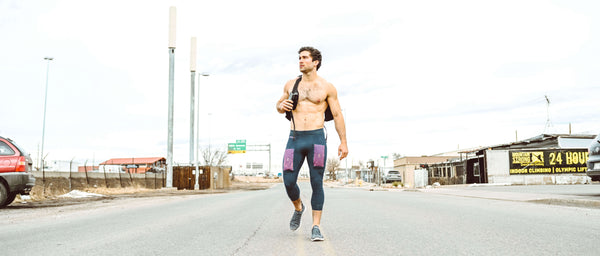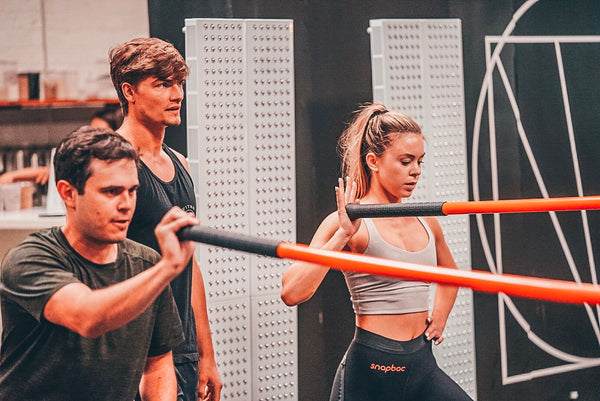Since high school gym class, we’ve been told how to exercise with the warm-up, stretch, workout, and cool down process, but modern science is challenging those old ideas and current lifestyles aren’t leaving us the time to squeeze it all in. Should we cut precious minutes from our primary workout in order to make space for the other important requirements? Would this help our training or actually diminish our results as there is less time spent on the hard work? They have already proven that our cool down exercises don’t do what we were always told, and some gym enthusiasts may even receive the same benefits simply walking from the gym floor to the lockers, showering and walking to the car - cool down complete. So is this also true with warm-up exercises? Are we simply following outdated advice because our gym teachers drilled it into our heads as teenagers?
We dug into the actual effects of proper muscle and body preparation to determine the true validity of these initial workout routines and found that our coaches, teachers, and trainers are still giving us solid guidance when it comes to the best way to train and challenge our bodies. We also found a clear distinction between the warm up and the stretch. They are both required at the beginning of our session, and they each have their own movements and roles to play. Take a look at why everyone, professional athlete, weekend warrior, and triathlon competitor alike need to heed the words of their former P.E. instructors to get the most out of their workout.
How to Properly Warm Up Before a Workout
We are going to break down the reasons for a warm up both physically and psychologically to show you exactly what you may be missing and how you might be hindering your power, performance, and growth as an athlete by skipping this essential step. We’ll dig in and see if warming up can actually reduce injuries, lessen muscle fatigue and decrease muscle stiffness the next day.Take a look at how preparing your body also prepares your mind and improves the outcome of your workout, competition, or big game, and lastly, we’ll show you the exact do’s and don’ts of a proper warm up.
Fight, Flight or Exercise
When we engage our muscles in explosive reactions, we set off a hormonal chain of signals within the central nervous system. It has been studied and colloquially labeled as fight or flight due to the practical interpretation of demanding movement from our bodies in the case of a dangerous situation -think running from the saber-tooth tiger or staying to fight it off; either way calls for an immediate contraction of muscles. This instant clenching and forceful extraction of energy causes stress hormones to release in a rush of endorphins to help you survive. These are not the chemicals you want in your body when in the throws of competition or training as they are short-lived with a massive crash creating early onset fatigue at the beginning of the game.
You want your body prepared for endurance and stress-free energy expenditure. You need the hormonal spike to stay with you till the end and your strength to come from physical conditioning not from adrenaline. This means sending the right signals to your nervous system, and this begins with properly warming up the body in preparation for the long haul.

It’s Not Just About the Bulging Muscles
Yes, we found a warm up benefits the muscles running through our extremities and core, but the primary advantage to getting the body up and moving was to our cardiovascular and respiratory systems. It seemed obvious when many trainers compared this to rolling from your bed to your sneakers and out the door after a long night’s rest and immediately pushing your body as hard and fast as you can. That seems absurd, and we wouldn’t do it. Yet, we do because it’s the same as starting from sitting in the locker room, at home, at the office, or in your car. You are taking your body from a state of rest and throwing it into high performance.
There were studies done using an Electrocardiogram (ECG) to measure the effects of high energy output before and after warming up. A startling 70% of the subjects in the test group who did not warm up showed irregular ECG data due to the heart not receiving the proper amount of blood. Those same subjects then did a mere two minutes of a cardio warm-up and 98% had improved ECG readings. This is why it is essential to gradually build-up your heart rate so that it can begin to pump more blood and carry more oxygen where it is needed.
Let’s Talk About Oxygen
We’re going to break the stereotype of ‘jocks and science don’t mix’ and throw in a little biology because we know that knowledge makes us better athletes. Let’s start with the basics of liquid and gas. Oxygen comes in through the mouth and into the lungs as a gas and is absorbed into the tissue and then carried throughout the body in the blood, a liquid. It does so by binding to your hemoglobin. The benefit of a warm up is in the name because it warms the body up. This is often left to the cold or warm muscles, but the fact is movement raises the temperature of the blood running through our veins. As the blood heats up, the bonds between the hemoglobin and oxygen grown weaker, and this makes the oxygen more available to the muscles that need it. Read more power and more endurance!

Warming Up and Its Relation to Heat
Not only does the blood heat up, but it brings that heat to the rest of the body as well. This plays a major role in preparing the large muscles and awakening the smaller muscles that have been dormant throughout the day. When the veins start heating up, they begin to activate the capillaries, or small veins that interconnect the large veins.
When we are in a relaxed state, only 15-20% of our blood flow is directed to the larger skeletal muscles and the capillaries are actually closed to help redirect the blood to the abdomen and brain. When we allow our bodies to warm up, we feel the heat as the small veins open and 70-75% of our blood now begins to flow to our larger muscle groups. This brings in more oxygen and available muscle strength throughout the body.
These studies have shown that proper dynamic warm up exercises increase power output and endurance from the first rep, throw or kick-off. This is because all of your muscles are ready to react and are properly fueled for the task. As an athlete, the last thing you want is to train or compete at a reduced level. If you’re going to go out there and give it all you’ve got, make sure your body can actually access its greatest potential!
Does a Warm Up Reduce the Risk of Injury?
There’s actually very little science done to prove or disprove this line of thought, but that is mostly due to athletes not wanting to risk time and development being part of a study that could take them out of the game. Studies have been conclusive in animal testing as they put them under great physical strain from a resting state and from an active state. The studies proved that it took significantly more force and muscle length to cause an injury to warm muscles than it did to cool muscles. If you would like to test this hypothesis yourself, then be our guest, but an athlete never comprises his greatest asset, and that is the body! So according to current studies, the answer is yes, getting the muscles heated and flooded with oxygen does reduce your risk of injury.
There’s also great benefit to the ligaments and joints. When the blood starts flowing, the lubrication increases where it is needed. Warming up the major joints prepares them for the strain and movement to come. You don’t want to find out under a loaded bar or during a pivot on the field that a joint wasn’t ready for the weight or the twist. That is an injury that can put you out for many days ahead and possibly for months.

Mental Benefits from a Full Warm-up
Have you ever heard a coach yell, “Get your head in the game!”? If so, it could be due to a lack of preparation before you began. It can be a real challenge to even get ourselves geared up for a strenuous workout, but a proper warm-up gets our body ready which also brings focus to our mind. When you do the right moves while getting ready for your sport or workout, you are forced to mentally think through the action to come. By seeing what you are about to do and preparing for it, the mind prepares itself by visualizing the desired outcome. Numerous studies have shown improved athletic performance in those who were mentally prepared for the task. It sharpens your technique, coordination, and skill. It also helps you to overcome the physical pains and discomfort because you already know they are coming, and you are mentally ready for it.
Stretching vs. The Warm Up
Too often these two are lumped in together, but they are not the same thing, and both are required. The warm up is exactly what it says, warming up, which entails all of the benefits above. Stretching is the intentional lengthening of the muscles. It is important to not cause any pain when stretching as you don’t want any microtears that deter from your physical output to come. You simply want to bring in some elasticity to the muscle to reduce tightness or soreness during your movements and the next day.
You do need to be moderate in your stretches as an overstretched muscle can hinder you just as much as an under-stretched muscle. You want to be ready for some give but still have the power of a tight contraction. For this reason, you do not want to do static stretches before a workout, meaning holding a pose. Focus on dynamic stretches, poses that move and bounce, like spreading your legs hip length apart and touching left, center, right.
The Importance of Warming Up Right
So what does a proper warm-up and stretch look like? That depends entirely on what you are about to do! You want to give 10 to 20 minutes to your warmup, less if you are doing a low intensity workout and more if you are about to push yourself. If you are a highly trained athlete, you will need a longer warm up, as your heart is well-conditioned and can maintain a lower rate for longer. Regardless of your sport, you want a mix of cardio and dynamic stretching to prepare.
The balance is that you don’t want to fatigue yourself, so the warm-up should be at 60-80% of the intensity you are about to enter, so you can slowly work up to that. As for the types of warming up, that depends on what muscles you are about to use. If you are lifting weights, mimic the moves without weight and work up the weight to 80% of your goal. If you are playing football, run cardio drills that work your lower body. Tennis and baseball should work up the heat in their upper body. Runners and swimmers can start slow and build their speed.No matter what you do, be sure to give yourself a few minutes rest before the big push to restore your energy, but don’t wait too long, or you will have to warm up once more.



